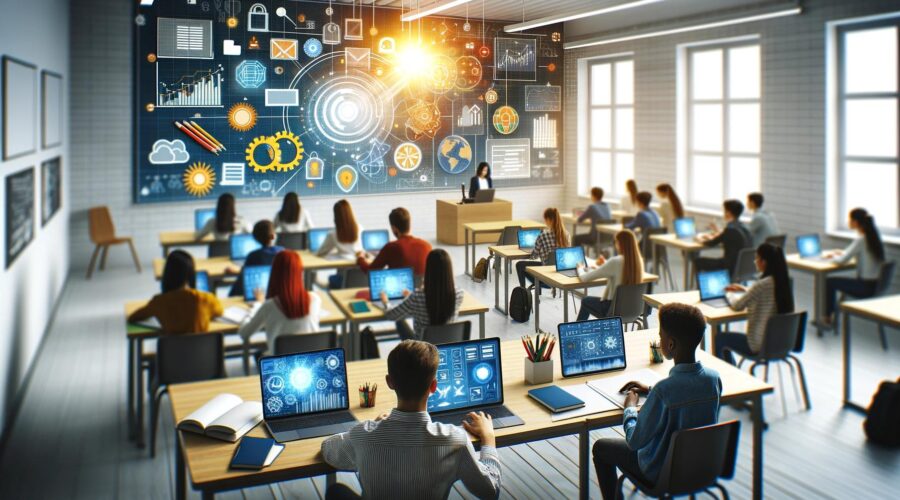Introduction
The landscape of education has been profoundly transformed by the advent of technology. In the past few decades, the integration of various technological tools and platforms has not only reshaped teaching methodologies but also expanded the horizons of learning opportunities. This article delves into the multifaceted impact of technology in modern education, exploring its benefits, challenges, and future implications.
The Psychological Impact of Technology on Students
The widespread integration of technology in education has significant psychological implications for students. While it offers numerous educational benefits, its impact on mental health and cognitive development is a growing area of concern and study.
One of the major psychological effects is related to screen time. Excessive use of digital devices can lead to issues such as reduced attention spans, sleep disturbances, and heightened anxiety. The blue light emitted by screens can disrupt sleep patterns, which is crucial for the cognitive and emotional development of young learners. Moreover, constant exposure to rapidly changing stimuli on screens can impair the ability to focus on longer, more contemplative tasks essential for deep learning.
The rise of social media and online communication platforms, often integrated into educational technology, also impacts students’ social skills and self-esteem. While these platforms can enhance collaboration and connectivity, they can also lead to feelings of isolation, inadequacy, and cyberbullying. The pressure to present a curated persona online can affect students’ self-image and social interactions, leading to increased anxiety and social pressure.
However, technology also provides tools for positive psychological growth. Educational apps and games designed with cognitive and emotional development in mind can enhance skills like problem-solving, creativity, and emotional intelligence. Additionally, technology can be a boon for students with learning disabilities, offering customized learning experiences and fostering a sense of independence and confidence.
Balancing technology use with physical activity, mindfulness practices, and face-to-face interactions is essential. Educators and parents play a crucial role in monitoring and guiding students’ digital consumption, ensuring it contributes positively to their mental well-being. By adopting a balanced approach, the psychological impacts of technology can be managed to harness its benefits while mitigating its drawbacks.
Revolutionizing Learning Environments
Digital Classrooms
The traditional chalk-and-talk classrooms have evolved into dynamic digital environments. Interactive whiteboards, digital textbooks, and online resources have replaced conventional teaching tools. These technological advancements foster a more engaging and interactive learning experience, accommodating different learning styles and needs.
Virtual and Augmented Reality
Virtual and Augmented Reality (VR and AR) have introduced an immersive dimension to education. These technologies allow students to experience and interact with 3D models, historical events, and complex scientific concepts, making abstract ideas more tangible and comprehensible.
Enhancing Accessibility and Inclusivity
E-Learning Platforms
Online learning platforms and courses have democratized education, making it accessible to a wider audience. Platforms like Coursera, Khan Academy, and edX offer courses from top universities, enabling learners from remote or underprivileged areas to access quality education.
Assistive Technologies
For students with disabilities, technology has been a game-changer. Assistive technologies like speech-to-text software, screen readers, and specialized apps have made education more inclusive, catering to the needs of all learners.
Personalized Learning
Adaptive Learning Systems
Technology has paved the way for adaptive learning systems that tailor educational content to the individual learner’s pace and style. These systems analyze students’ performance and provide personalized resources, ensuring a more effective and individualized learning experience.
Data-Driven Insights
Educational technology also enables the collection and analysis of student data. This data-driven approach assists educators in identifying learning gaps and crafting strategies to address specific needs, thereby enhancing the overall learning outcome.
Collaboration and Global Connectivity
Online Collaboration Tools
Tools like Google Classroom, Microsoft Teams, and Zoom have facilitated collaboration beyond geographical boundaries. Students and teachers can now engage in real-time discussions, work on group projects, and exchange ideas globally, fostering a more connected and diverse educational experience.
Cultural Exchange and Global Awareness
Through technology, students gain exposure to different cultures and global issues. This fosters a sense of global citizenship and empathy, preparing them for a more interconnected world.
Technology and Teacher Development
The integration of technology in education necessitates a parallel evolution in teacher development. In this digital era, educators are required to continually adapt and enhance their skills to effectively incorporate technology into their teaching strategies. This necessity for professional growth extends beyond basic digital literacy; it involves a deep understanding of how technological tools can be optimally used to enrich learning experiences.
Professional development in the age of technology includes training teachers in the use of educational software, online platforms, and digital tools. This training is crucial for implementing these tools in the classroom and understanding how to blend them with traditional teaching methods. Moreover, teachers must learn to navigate the digital landscape with a critical eye, evaluating new technologies for their educational merit and suitability for their particular student demographic.
The tech-savvy skills required in today’s classrooms go beyond just technical know-how. They encompass a broad range of competencies, including digital content creation, online classroom management, and the use of data analytics to track and enhance student performance. By equipping educators with these skills, we ensure that they are not just passive recipients of technological change but active and informed participants in shaping a future-ready educational environment. This shift represents a significant opportunity for educators to redefine their role and impact in the modern classroom, preparing students effectively for a rapidly evolving digital world.
Challenges and Ethical Considerations
Digital Divide
Despite the benefits, the digital divide remains a significant challenge. The disparity in access to technology between different socio-economic groups can exacerbate educational inequalities.
Cybersecurity and Privacy
With the increasing use of digital platforms, concerns about cybersecurity and the privacy of students’ data have emerged. It’s imperative for educational institutions to implement robust security measures to protect sensitive information.
Preparing for the Future
Developing Digital Literacy
As technology becomes integral to education, there’s a growing need to incorporate digital literacy in curricula. Teaching students how to responsibly use technology and critically evaluate online information is essential for their success in a digital world.
Continuous Innovation
The field of educational technology is continually evolving. Staying abreast of the latest trends and tools is crucial for educators to effectively integrate technology into their teaching practices.
Global Trends and Future Outlook
The education landscape is continuously evolving, shaped by global trends and technological advancements. As we look towards the future, several key trends are emerging, indicating a transformative shift in how education is delivered and experienced.
One significant trend is the growing emphasis on personalized learning facilitated by artificial intelligence and machine learning. These technologies enable the creation of customized educational experiences, adapting to individual learning styles and speeds. AI algorithms can analyze student performance data in real time, providing teachers with insights to tailor their instruction and support. This trend points towards a future where education is more student-centric, responsive, and effective.
Another trend is the increasing adoption of virtual and augmented reality in classrooms. These technologies offer immersive learning experiences, making complex concepts more accessible and engaging. For instance, VR can transport students to different historical periods or geological formations, while AR can bring abstract scientific theories to life. This experiential form of learning is likely to become more prevalent, providing students with deeper, more interactive educational experiences.
Moreover, the concept of global classrooms is gaining traction. Technological advancements are making connecting and collaborating easier for students and teachers worldwide. This interconnectedness promotes a more inclusive education system, where learners can gain diverse perspectives and understand global issues, preparing them for a more interconnected world.
In the future, we may also see a greater integration of sustainability in education technology, aligning with global efforts to address environmental challenges. Green technologies and eco-friendly practices in educational institutions will reduce their carbon footprint and instill a sense of environmental responsibility in students.
As we embrace these trends, the future outlook for education is one of inclusivity, innovation, and interconnectedness. The ongoing technological revolution in the educational sector promises to redefine learning, making it more personalized, immersive, and globally oriented.
Conclusion: Embracing the Future of Education with Technology
As we navigate through the evolving landscape of modern education, it becomes increasingly clear that technology is not just an adjunct but a pivotal force reshaping how we teach and learn. The journey so far has revealed that technology in education is a double-edged sword; while it brings unparalleled opportunities for enhanced learning and global connectivity, it also poses challenges that require careful navigation.
The future of education, as shaped by technology, promises a more personalized, immersive, and inclusive learning experience. It opens doors to global classrooms, where diversity of thought and cultural exchange enrich the educational experience. However, this bright future is contingent upon our ability to manage the challenges—be it the digital divide, cybersecurity concerns, or the psychological impacts on students.
Educators, policymakers, and technology developers must collaborate to ensure that the technological advancements in education are accessible, secure, and beneficial to all learners. This includes investing in teacher training, developing robust privacy protocols, and designing inclusive and adaptive learning tools. Furthermore, a balanced approach towards screen time and the integration of digital literacy into curricula are crucial steps in preparing students for a digital world while maintaining their mental well-being.
As we stand at the intersection of education and technology, the path forward is one of cautious optimism. By embracing the transformative power of technology with a mindful approach to its challenges, we can unlock a future where education is a dynamic, inclusive, and enriching journey for every learner. The onus is on us to harness this potential and shape an educational landscape that is not only technologically advanced but also ethically grounded and human-centric.

